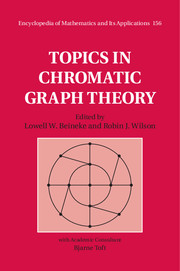Book contents
- Frontmatter
- Contents
- Foreword
- Preface
- Preliminaries
- 1 Colouring graphs on surfaces
- 2 Brooks's theorem
- 3 Chromatic polynomials
- 4 Hadwiger's conjecture
- 5 Edge-colourings
- 6 List-colourings
- 7 Perfect graphs
- 8 Geometric graphs
- 9 Integer flows and orientations
- 10 Colouring random graphs
- 11 Hypergraph colouring
- 12 Chromatic scheduling
- 13 Graph colouring algorithms
- 14 Colouring games
- 15 Unsolved graph colouring problems
- Notes on contributors
- Index
- References
7 - Perfect graphs
Published online by Cambridge University Press: 05 May 2015
- Frontmatter
- Contents
- Foreword
- Preface
- Preliminaries
- 1 Colouring graphs on surfaces
- 2 Brooks's theorem
- 3 Chromatic polynomials
- 4 Hadwiger's conjecture
- 5 Edge-colourings
- 6 List-colourings
- 7 Perfect graphs
- 8 Geometric graphs
- 9 Integer flows and orientations
- 10 Colouring random graphs
- 11 Hypergraph colouring
- 12 Chromatic scheduling
- 13 Graph colouring algorithms
- 14 Colouring games
- 15 Unsolved graph colouring problems
- Notes on contributors
- Index
- References
Summary
Perfect graphs were defined by Claude Berge in the 1960s. They are important objects for graph theory, linear programming and combinatorial optimization. Berge made a conjecture about them (now called the strong perfect graph theorem or SPGT) which was proved by Chudnovsky, Robertson, Seymour and Thomas in 2002. This survey about perfect graphs mostly focuses on the SPGT.
Introduction
Every graph G clearly satisfies χ(G) ≥ ω(G), where ω(G) is the clique number of G, because the vertices of a clique must receive different colours. A graph G is perfect if every induced subgraph H of G satisfies χ(H) = ω(H). A chordless cycle of length 2k + 1, for k ≥ 2, satisfies 3 = χ > ω = 2, and its complement satisfies k + 1 = χ > ω = k; these graphs are therefore imperfect. Since perfect graphs are closed under taking induced subgraphs, they must be defined by excluding a family F of graphs as induced subgraphs. The strong perfect graph theorem (SPGT for short) states that the two examples just given are the only members of F.
Let us make this more formal. A hole in a graph G is an induced cycle of length at least 4, and an antihole is a hole of G. A graph is Berge if it does not contain an odd hole or an odd antihole. The following was conjectured by Berge [3] in the 1960s and was the object of much research until it was finally proved in 2002 by Chudnovsky, Robertson, Seymour and Thomas [13].
Theorem 1.1 (Strong perfect graph theorem) A graph is perfect if and only if it is Berge.
One direction of the proof is easy: every perfect graph is Berge since, as we observed above, odd holes and antiholes satisfy χ = ω + 1. The proof of the converse statement is very long and relies on structural graph theory.
Information
- Type
- Chapter
- Information
- Topics in Chromatic Graph Theory , pp. 137 - 160Publisher: Cambridge University PressPrint publication year: 2015
References
Accessibility standard: Unknown
Why this information is here
This section outlines the accessibility features of this content - including support for screen readers, full keyboard navigation and high-contrast display options. This may not be relevant for you.Accessibility Information
- 2
- Cited by
